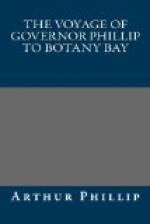The only places where it was found practicable to land was a-breast of their first station (which is the place described by Captain Cook, and where the people landed with the utmost difficulty,) and at Sydney Bay on the south end of the isle, the outer breaker off the westernmost point in sight bearing north-west by west half west.
Lord Howe Island was discovered by Lieutenant Henry Lidgbird Ball, Commander of his Majesty’s tender Supply, on the 17th February, 1788, and was so named by him, in honour of the Right Honourable Lord Howe. At the same time he observed a remarkably high pyramidical rock at a considerable distance from the island, which has been named Ball’s Pyramid; from a correct drawing of this rock and others near it, the annexed engraving was taken.
There is no danger in approaching Lord Howe island, the Supply anchored there in thirteen fathoms, sand and coral; but there lies about four miles from the south-west part of the pyramid, a dangerous rock, which shows itself a little above the surface of the water, and appears not to be larger than a boat. Lieutenant Ball had no opportunity of examining whether there is a safe passage between them or not. The island is in the form of a crescent, the convex side towards the north-east. Two points at first supposed to be separate islands, proved to be high mountains on its south-west end, the southernmost of which was named Mount Gower, and the other Mount Lidgbird; between these mountains there is a very deep valley, which obtained the name of Erskine Valley; the south-east point was called Point King, and the north-west point, Point Phillip. The land between these two points forms the concave side of the island facing the south-west, and is lined with a sandy beach, which is guarded against the sea by a reef of coral rock, at the distance of half a mile from the beach, through which there are several small openings for boats; but it is to be regretted that the depth of water within the reef no where exceeds four feet. They found no fresh water on the island, but it abounds with cabbage-palms, mangrove and manchineal trees, even up to to the summits of the mountains. No vegetables were to be seen. On the shore there are plenty of ganets, and a land-fowl, of a dusky brown colour, with a bill about four inches long, and feet like those of a chicken; these proved remarkably fat, and were very good food; but we have no further account of them. There are also many very large pigeons, and the white birds resembling




